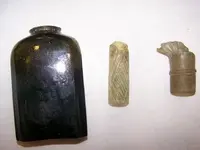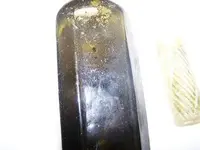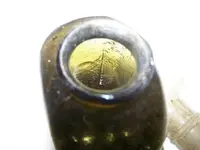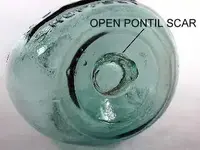You are using an out of date browser. It may not display this or other websites correctly.
You should upgrade or use an alternative browser.
You should upgrade or use an alternative browser.
I would appreciate any help
- Thread starter MichaelB
- Start date
gleaner1
Silver Member
- Joined
- Feb 1, 2009
- Messages
- 4,495
- Reaction score
- 1,039
- Golden Thread
- 0
- Location
- Gateway to the 1000 Islands
- Detector(s) used
- Sometime(s)
- Primary Interest:
- Other
Looks like a decent snuff bottle, should be pontiled, check for one. I say 1840-1860. Nice piece!
gleaner1
Silver Member
- Joined
- Feb 1, 2009
- Messages
- 4,495
- Reaction score
- 1,039
- Golden Thread
- 0
- Location
- Gateway to the 1000 Islands
- Detector(s) used
- Sometime(s)
- Primary Interest:
- Other
plehbah, excellent question on color and category, we just call it olive or olive green, it's not awfully dark. I don't know if this is considered black glass or not (comments needed by Harry Pristis). MichaelB, a pic of the pontil would be icing on the cake.
traderoftreasures
Bronze Member
- Joined
- May 9, 2009
- Messages
- 2,211
- Reaction score
- 7
- Golden Thread
- 0
- Location
- central, Illinois
- Detector(s) used
- white's spectrum VX3
what please, is a pontil ?
Likely Guy
Hero Member
traderoftreasures said:what please, is a pontil ?
From: "Bill Lindsey
Bureau of Land Management (retired) - Klamath Falls, Oregon"
"A pontil mark is a variable size and type of scar left on the base of a bottle by a pontil rod. A typical pontil rod or "punte" was a long (4-6 feet) rod which was securely attached to the base of the just blown hot bottle. The rod had to be long enough so that the heat transference from the extremely hot (2000°+ F.) bottle did not reach the hands of the pontil rod holder. A pontil rod held the bottle during the steps in the bottle blowing process where the blowpipe is removed (cracked-off) from the bottle and that break-off point is "finished", i.e. the lip or finish is completed. Once the bottle is "finished", the pontil rod is sharply tapped which breaks it free of the bottle. The base of a bottle which was held with a pontil rod will almost always retain some evidence of the pontil rod attachment."
Attachments
traderoftreasures
Bronze Member
- Joined
- May 9, 2009
- Messages
- 2,211
- Reaction score
- 7
- Golden Thread
- 0
- Location
- central, Illinois
- Detector(s) used
- white's spectrum VX3
thanks a millionLikely Guy said:traderoftreasures said:what please, is a pontil ?
From: "Bill Lindsey
Bureau of Land Management (retired) - Klamath Falls, Oregon"
"A pontil mark is a variable size and type of scar left on the base of a bottle by a pontil rod. A typical pontil rod or "punte" was a long (4-6 feet) rod which was securely attached to the base of the just blown hot bottle. The rod had to be long enough so that the heat transference from the extremely hot (2000°+ F.) bottle did not reach the hands of the pontil rod holder. A pontil rod held the bottle during the steps in the bottle blowing process where the blowpipe is removed (cracked-off) from the bottle and that break-off point is "finished", i.e. the lip or finish is completed. Once the bottle is "finished", the pontil rod is sharply tapped which breaks it free of the bottle. The base of a bottle which was held with a pontil rod will almost always retain some evidence of the pontil rod attachment."
Similar threads
- Suggestion
- Replies
- 8
- Views
- 1K
Users who are viewing this thread
Total: 1 (members: 0, guests: 1)







